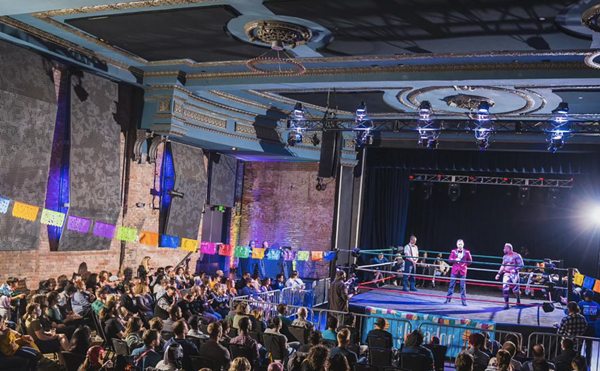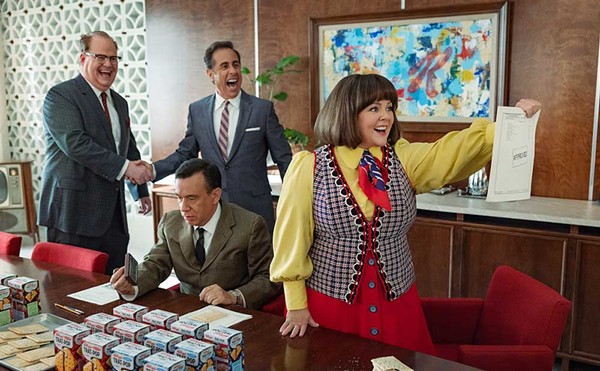In 1963, when the Ann Arbor Film Festival began, there were no Redbox or Netflix, VOD, YouTube, Steam, no Internet at all, no DVDs, not even VCRs. There were only three national television networks, and some UHF stations that showed movies late at night, and precious few of those in color. If you lived in a major city, you may have been lucky enough to have at least one theater that showed foreign films, or perhaps you could find a college film society that was screening prints of Kurosawa or Truffaut — to a handful of appreciative cinema buffs. In fact, the very notion of a film festival was still novel in America.
That was when Professor George Manupelli first launched the Ann Arbor Film Festival, on the campus of the University of Michigan, hosting 16 mm screenings of experimental shorts in the art and architecture building with seating for roughly 400. Attendance numbers aren't readily available, but it's safe to say the event was a success; just four years later, the festival's rising profile had attracted such ultra-hip luminaries as Andy Warhol and the Velvet Underground and Nico, who performed live. Of course, in the late '60s and early '70s, Ann Arbor was itself a blazing hotspot in the wider countercultural revolution, home to a host of artists, musicians, activists and radicals, from Iggy to John Sinclair. Long after the last draft card was burned, the festival remains to true to the curiosity and idealism that drove its creation.
Other film festivals mutated under market pressure to become celebrity-driven orgies for paparazzi, studio flacks and free-drink-chasing bloggers, all bellying up to ever-more-crowded bars. If you had attended, say, the Sundance Festival in 1979, you would scarcely recognize the same event today. Yet Ann Arbor maintains essentially the same vision it began with: serving as a showcase for eclectic, independent, experimental and utterly uncompromised works of art.
This continuity is being celebrated on the festival's half-century anniversary, with a lineup of presentations, panels and events that seek to connect past and future organically. While there is some debate, Ann Arbor is considered the second- or third-oldest continually running festival in the nation (behind only San Francisco or Columbus), and this year's programming reflects the history and continuing mission of the festival to keep breaking ground. More important, though, AAFF bills itself as the longest-running independent and experimental film festival in North America, and the largest U.S festival prominently featuring short experimental and artist-made indie works.
Among the highlights:
The opening night reception kicks off the festivities on Tuesday with a "creative black tie" mixer, complete with beer, wine and hors d'oeuvres from a variety of local vendors, which should cram the luxurious Michigan Theater's lobby elbow to elbow. One of the scheduled revelers will be Mr. Manupelli himself, now in his 80s, and hopefully primed to bask in the warm glow of film obsession that he helped foster.
• Wednesday features Out Night with a Q&A appearance by celebrated New York filmmaker Barbara Hammer, who, over her long career, has explored themes of gender identity, sensuality and relationships, and is considered a pioneer in lesbian and queer cinema.
• On Thursday, director Bruce Baillie will be in attendance for the first of three presentations of some of his visually arresting avant-garde classics, which have been a part of the A2FF scene since the beginning.
• At 11:59 p.m. on Friday and Saturday, one of the biggest names associated with the early festival will be represented with one of his least-marketable films. When George Lucas was a student at University of Southern California, influenced by experimental artists — such as the aforementioned Bruce Baillie and Stan Brakhage — he made a groundbreaking short called Electronic Labyrinth: THX 1138 4EB, which screened in Ann Arbor in 1968. He remade the film as 1971's dystopian sci-fi feature THX 1138, with a real budget and real stars, including Robert Duvall. The near-disastrous experience convinced him to try to manipulate the studio system to his advantage in his subsequent career. The film carries fascinating embryonic traces of Lucas' later space epics. Purists will be happy to note, THX 1138 is screening in its original, not digitally remastered, form.
• On Sunday, the festival awards are announced at 6 p.m. at the Michigan Theater, with a screening of selected winners following additional screenings at 8 p.m.
Among other notable presentations: more than 30 influential archival films from the AAFF's history; recent work from Palestine, Lebanon and Morocco, plus films by the great Syrian documentary filmmaker Omar Amiralay; two programs of Japanese avant-garde film from the 70s through the 2000s; not to mention gallery installations, live performances, parties, artist talks and more.
More than 5,000 films have screened over the festival's 50 years. Along with Lucas, other later-famous names include Gus Van Sant, Yoko Ono, Agnes Varda, Brian De Palma and Les Blank.
And while many films were made by now-famous artists like them, that doesn't blunt the impact of the lesser-known artists who have all contributed to the larger tapestry. To think the festival is just about stardom misses the point.
Executive Director Donald Harrison says that the festival's greatest value is in nurturing and developing new ideas slowly, like a germ culture growing in a laboratory. It is a process of seeding the clouds: It might not be any individual film or filmmaker that benefits from mainstream exposure, but the festival serves as a sort of laboratory to explore ideas and to share the results with other curious artists.
As Harrison explains: "You have somebody like Michael Moore, who came to the festival before Roger and Me and was very much influenced by a lot of the work that he saw on the screen. So it does play an important role within the landscape of cinema, especially for the artists who aren't already famous, but are at the forefront of shaping what's to come."
And not only do the festival's large, enthusiastic crowds get short films they'd be hard-pressed to find elsewhere. The opportunity to mingle with other creative people in the friendly, walkable and diverse city of Ann Arbor is also a major attraction.
Adds Harrison: "For us, our focus is really filmmakers who are working creatively outside of the commercial model. When you're not so caught up in trying to make a profit and in trying to fit it into this theatrical world, then you're more likely to make really interesting work. If you don't expect to 'make it' with this film, then you are going to make something that is wholly your vision."
Harrison believes that it is this independent, risk-taking spirit is the ethos that has run through the festival all these years, and helped to encourage artists to make timeless works.
Liberated from the grinder of the industry and commerce, the sort of films that play in Ann Arbor are unique, vibrant pieces that you're still unlikely to find anywhere else.
"To have an outlet where these films can kind of come from out of the blue ... it's like magic when you discover that there is this artist that made something beautiful and brilliant, and all of a sudden it's influencing other artists who've seen it and talked about it."
To use Harrison's term, that's how the art of film "regenerates." That's how this film festival regenerates as well.
The Ann Arbor Film Festival runs through Sunday at a number of Ann Arbor locations. See aafilmfest.org/50.
Corey Hall writes about film and performance for Metro Times. Send comments to [email protected].





